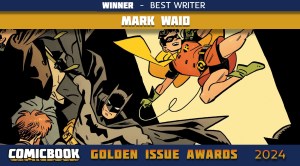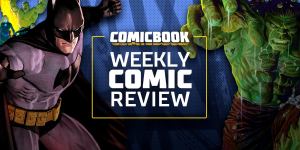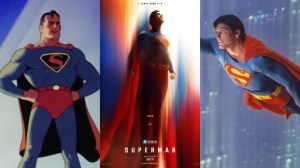It’s a Superman kind of year, isn’t it? I’ll celebrate the only way I know how, by grabbing a random comic out of a longbox and seeing just what I have here. This week, I have a book I had completely forgotten about.
Videos by ComicBook.com
In 1992, DC published the “Superman Special,” a 64 page one shot written and drawn by Walt Simonson. (It’s about 50 pages of story, but let’s not quibble here.)

The book picks up a thread that John Byrne’s reboot left a few years earlier. In “Superman” #22, John Byrne told a story in which Superman killed three Kryptonians who had killed the entire population of another earth. This book starts off with Superman lamenting that fact, once again, and erecting a statue in his Fortress of Solitude to remind himself to never kill again.
This is called foreshadowing, and it’s convenient to have when Superman goes up against a bad dude who keeps taking his powers away and using them against Superman. Would killing this doppelganger made of sand be the only way to beat him? Superman has to wonder…
The mystery feels spread out a little bit thin, but Simonson does keep progressing the story and ramping up the drama as he goes. It’s not the deepest or most complex story and the ending happens a little quickly for me, but as a nice old school piece of superheroic storytelling, it does the job.
There is a bigger morality tale underneath everything in this special, if you want to read it that way. But there’s also a burst of fun and classic Superman action. The Newsboys show up to help Jimmy Olsen and Lois Lane find Superman when he needs help. Lex Luthor is playing his diabolical best self, being a cunning business man desperately trying to find any way to rid himself of the Kryptonian. Lois Lane is fighting Clark Kent for a story she’s sure he’s going to steal from here. (He’s not. He just needs to beat here there because Superman is needed first.)
Superman wears red shorts on the outside, has short hair with a spit curl, and isn’t all blue or all red. It was a good time for Superman comics.
The Look of the Thing

Simonson is an amazing storyteller and page designer. There are some funky character drawings in this book, to be honest, but they’re more than made up for by the page layouts he uses. They break a lot of the “rules” of comic book storytelling that I usually like more, but they work. They’re powerful on the page. There were some complaints in the late 80s that superhero comics, in general, were starting to look boring. Simple panel to panel storytelling with terribly undynamic figures and bored-looking people was becoming too common. That led, in large part, to the Image generation, which sought to fight against that, perhaps at times to the other extreme.
Simonson knows just when to break a panel border or two overlap panels or to arrange them in a weird reading order. He gets away with it because he’s so good at it. It’s scary. His pages are a treat for the eyes while still maintaining the storytelling.
He’s paired up, as usual, with John Workman on lettering. Workman makes every moment work with his lettering, from the big bombastic explosions — and this book has its fair share of those — to the little moments. Take this simple moment, where Simonson establishes the outside of the Daily Bugle building before cutting in on Lois Lane walking down the hallway. He connects the two with sound.

Workman sells that with the city street noises in the first panel transitioning into the simple, clean, spartan click sounds of shoes on tile in the next. It’s such a simple transitional thing, but it adds to the work in a way few others would be able to do, or would even think to do.
Comparison Shopping
The one thing that surprised me the most in reading this book is realizing how similar Simonson’s style is to other artists who are his contemporaries.
In Clark Kent’s face and clothes, I can see hints of Howard Chaykin. It’s that dark haired man with the square jaw and the boxy suits that stick out so much.
You can also see a lot of Frank Miller in some of his character designs, notably in faces like Jimmy Olsen’s.
And, of course, the direct influence of Jack Kirby on Simonson cannot be underestimated. The power is clearly being channeled from that direction.
Working in the other direction, you can see Erik Larsen’s style in this book, too. The influences are the same, and Larsen was also influenced by Simonson and all his contemporaries, as well.
The Pin-Ups
The back of the book features a terrific pin-up section, featuring the likes of Frank Miller, Geof Darrow, Barry Windsor-Smith, and the interesting pairing of Curt Swan with Art Thibert. Nothing against Thibert, but his style is not the first I’d pair up with Swan’s. It works well to bring Swan’s style up to a more contemporary one for the time. (Whether or not you wanted Curt Swan’s work to look like one of the cool hip kids’ in 1992 is another question.)

Oh, and Todd McFarlane contributes a cool pin-up, too. This and “Invasion” would be the only two times he’s ever drawn Superman in a comic that I can think of, right?
Where Can You Get This Book?
It doesn’t look like this book is available digitally, nor has it ever been reprinted.
But, it’s a Superman story by Walt Simonson. Someone has to remember it and put it in a collection eventually…. I hope.
PipelineComics.com|| Twitter || Instagram || E-mail || YouTube





